Sue Burke's Blog, page 80
July 17, 2012
Adam Smith died today, July 17, in 1790
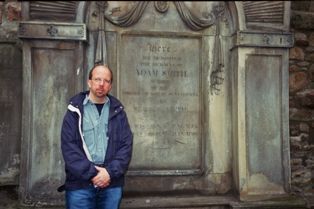
If you haven’t read Adam Smith, you probably think he supports free-for-all capitalism and is thoroughly pro-business; governments should be small and do little.
If you have read his most important book, The Wealth of Nations, you know that isn’t true. He considered the people who run businesses often to be fools and cheats, and believed that government ought to do many specific things, such as provide public welfare for the unemployed and run certain public projects rather than privatize them, because privatization would lead to cheating and ruination.
I took this photo of my husband at Smith's burial place in Canongate Kirkyard in Edinburgh, Scotland. Note the coins left in tribute on the headstone — small copper coins from all over the world. Smith’s fans are, appropriately, thrifty.
In honor of the anniversary of his death, here are some excerpts from The Wealth of Nations that may be good advice for our times:
“Our merchants and master-manufacturers complain much of the bad effects of high wages in raising the price, and thereby lessening the sale of their goods both at home and abroad. They say nothing concerning the bad effects of high profits. They are silent with regard to the pernicious effects of their own gains. They complain only of those of other people.”
Book I, Chapter IX
“The interest of the dealers, however, in any particular branch of trade or manufactures, is always in some respects different from, and even opposite to, that of the public. To widen the market and to narrow the competition, is always the interest of the dealers.... The proposal of any new law or regulation of commerce which comes from this order, ought always to be listened to with great precaution, and ought never to be adopted till after having been long and carefully examined, not only with the most scrupulous, but with the most suspicious attention. It comes from an order of men, whose interest is never exactly the same with that of the public, who have generally an interest to deceive and even to oppress the public, and who accordingly have, upon many occasions, both deceived and oppressed it.”
Book I, Chapter XI, Part III, Conclusion of the Chapter
“All for ourselves, and nothing for other people, seems, in every age of the world, to have been the vile maxim of the masters of mankind.”
Book III, Chapter IV
“Though the principles of the banking trade may appear somewhat abstruse, the practice is capable of being reduced to strict rules. To depart upon any occasion from these rules, in consequence of some flattering speculation of extraordinary gain, is almost always extremely dangerous, and frequently fatal to the banking company which attempts it.”
Book V, Chapter I, Part III
— Sue Burke
July 15, 2012
A hike in the mountains
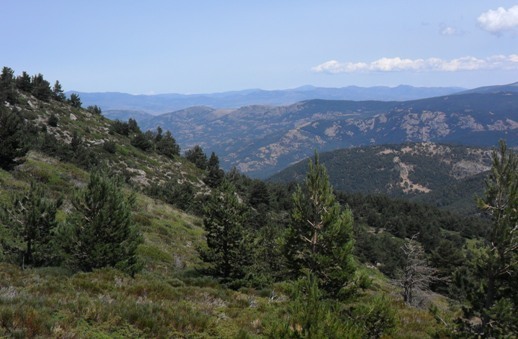
Beautiful: My husband and I spent yesterday hiking in Peñalara Park in the peaks of the Guadarrama Mountains near Madrid.
You can get there in a two-hour ride by commuter train, changing trains in the mountain town of Cercedilla to a narrow-guage line that snakes up the sides of the mountains to the park. More than 150,000 people visit each year — even a few foreign tourists who discover that Madrid exists beyond the Prado Museum and tapas bars.
A few more photos here:
http://www.facebook.com/media/set/?set=a.10150977508858611.428818.537088610&type=1
The park’s website, in Spanish:
http://www.parquenaturalpenalara.org/
— Sue Burke
July 11, 2012
Terra Nova: summer translating
For one of my summer projects, I’m translating two stories for a Terra Nova anthology. This is an international project with the goal of bringing some of the best English-language stories to Spanish, and the best Spanish-language stories to English.
In truth, a lot of stories get translated from English to other languages, although the fiction selected for the first edition of this anthology are excellent, including works by Ken Liu, Ian Watson, and Ted Chiang. But few short stories from other languages get translated into English, which makes this project unique. The anthology will include stories from Spain and Latin America translated into English.
I’ve joined the project as a translator, along with Lawrence Schimel, and I’m translating two stories:
In “Cuerpos” (Bodies) by Juanfran Jiménez, everyone wants to be someone else, literally, and no one wants to tell the truth about why they want new bodies.
“Enciende una vela solitaria” (Light a Solitary Candle), takes social networks to their extreme evolution. The author, Victor Conde, has won Spain’s most prestigious literary and science fiction awards.
I’ll keep you posted on this unique project, which should be available for purchase before the end of the year. The website:
http://novaficcion.wordpress.com/foreword/
— Sue Burke
July 7, 2012
They’re running with the bulls in Pamplona again
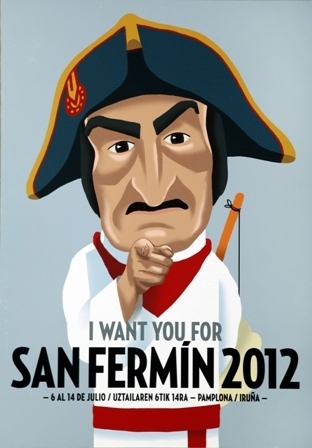
The San Fermín fiesta has begun in Pamplona, Spain, and its most famous activity, the running of the bulls — encierro in Spanish. Every day at 8 a.m starting today and continuing to July 14, bulls will run through downtown from pens to the bullring, and thousands of people will run with them.
Today’s run featured bulls from the Dolores Aguirre ranch. It took them 2 minutes 53 seconds to cover the distance, and for the most part the bulls were “noble” and took little notice of the crowds. However, one man, age 73, was gored in the leg shortly after the bulls left the pen, and at the end, a bull’s horn caught a man’s collar and kerchief (red kerchiefs are traditional at the fiesta) and he was dragged down the street into the bullring. He suffered only a few bruises.
You can see it here:
http://www.rtve.es/noticias/20120707/sanfermines/543460.shtml
Note that there are six bulls accompanied by six steers, which are tan-colored, larger, and wear bells. The steers know the route and make sure the bulls don’t get lost or frightened.
The goal of a runner (as opposed to los valientes, the “valiant” participants who stand off to the side and avoid the bulls as much as possible) is to run directly in front of the horns. The massive number of runners on weekends makes this more difficult, and several runners were injured in falls as a result of the crowds.
Of course, the fiesta includes a lot more activities. The official poster (above) depicts one of the “big heads,” specifically a character that roams through the streets and chases people, especially children, to their delight. The fiesta also offers music, dancing, religious processions for Saint Fermín, and fireworks.
You can follow the Sanfermines at the website of Radio Television Española, which has covered the fiesta since 1982. A staff of 70 people and 30 cameras are hard at work. Scroll all the way down on the page and you can watch the encierro from different cameras along the route:
http://www.rtve.es/noticias/san-fermin/
Why run with the bulls? Though he was speaking about something else, Robert A. Heinlein explained it concisely: “Nothing gives you more zest than running for your life.”
— Sue Burke
July 2, 2012
Are these great hats or what?
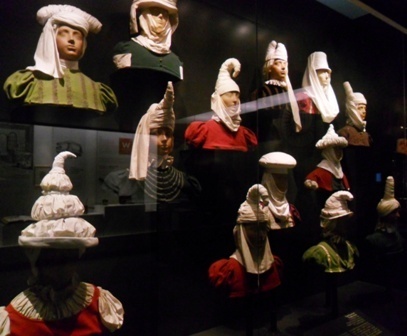
An explanation: Last weekend my husband and I went for a brief vacation in San Sebastián/Donostia. That’s a town in Spain in Basque Country on the northern Atlantic Coast near the boarder with France.
While there, we visited the San Telmo Museum, housed in a former Dominican monastery. It contained art and historical and cultural items from Roman times to the present. The section on Basque culture included this display of a recreation of headdresses, which was described this way:
“Basque headdresses, cotton and silk, hand sown. 20th century reproductions. The fabric headdresses worn by married women and widows indicated their marital state, locality, and economic status. But it was their supposed phallic symbolism that caused ecclesiastical authorities to ban them in the early 17th century.”
Married women wore the headdresses with the supposed phallic symbols and widows wore the plain ones.
As a writer, I had this reaction: We need to make our fiction as strange as reality. And make our reality as strange as it used to be.
Meanwhile, you can see a few photos of beautiful beaches and breathtaking scenery from the rest of the long weekend in San Sebastián/Donostia as a Facebook album here:
http://www.facebook.com/media/set/?set=a.10150947321523611.425670.537088610&type=1
— Sue Burke
June 26, 2012
In memory of Sue Blom: Madrid on Wheels
My friend and fellow writer Suzanne Allés Blom died June 23rd in Milwaukee, Wisconsin, due to cancer. There were several friends present, who had been reading aloud a favorite book and discussing a topic of interest to her, politics, and her passage was peaceful.
In 2000, shortly after I moved to Spain, Sue came to visit, and she helped me write an article for the November 2000 issue of In Madrid, an English-language newspaper.
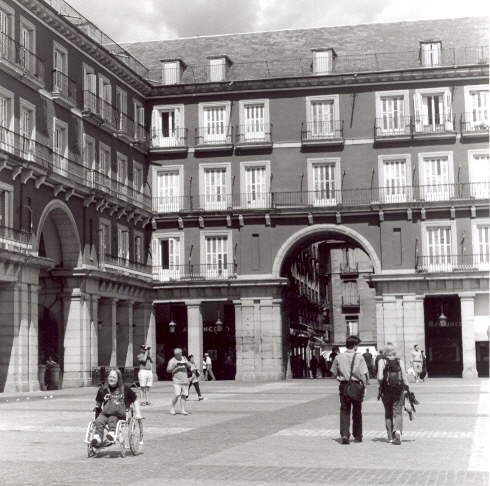
Photo: Suzanne in Plaza Mayor
Madrid on Wheels
story and photos by Sue Burke
My friend Suzanne thought the guards were going to carry her out of the Museo del Ejército. They headed toward the door, but then they turned, and, to her horror, cheerfully carried her in her wheelchair up the grand staircase to the second floor.
It’s a military pride thing, I guess. She had an obvious interest in historic weapons, and they weren’t going to let her roll away without seeing everything, even if her wheelchair didn’t fit in the museum’s elevator. They didn’t accidentally drop her, either. It’s a long fall down a flight of stairs.
Suzanne Allés Blom, a American friend, visited this summer. As soon as she mentioned a visit in an e-mail, I began studying Madrid for handicapped access. It didn’t look good: stairs everywhere. Two steep steps to get into my apartment building – maybe she could hoist herself up using crutches and a handrail, like the old ladies in my building. Someone would have to open the heavy door for her, though. She couldn’t come and go on her own.
She’d have to use crutches in the elevator, too. The door didn’t come close to the recommended width of 70 cm to let in a wheelchair. I could only pray to Santa Ascención, patron of lifts, that it wouldn’t break down for two full weeks, or she’d have to live in the lobby.
And what was there to do in Madrid on wheels for two full weeks? She cruised the web, I searched the bookstores and tourist offices. She found nothing. I found exactly one book, the Dorling Kindersley Eyewitness guide to Madrid. It listed wheelchair accessible sites, but added ominously, “Phone to check details. . . . On the whole, Spain is not wheelchair friendly.”
A staff member of the Confederación Coordinadora Estatal de Minusválidos Fisicos de España sat down with me and offered advice: the three big art museums are fine, the Palacio Real has an elevator, and the zoo and Parque de El Retiro are pleasant. He also recommended Atocha train station, with its impressive indoor garden and accessible restaurants and shops. I hadn’t thought of that, but it made sense, since I can roll heavy suitcases through it without trouble.
I mentioned that I don’t have a car. “That’s a real problem,” he said.
Only 40 subway stations have lifts, none in the center of the city. One out of three buses are “piso bajo” and in theory can accommodate wheelchairs, but have you ever seen someone in a wheelchair using them? Eurotaxis are taxis specially equipped to handle wheelchairs, but only 28 serve Madrid, so you have to call and wait, and perhaps pay a bit more.
But even if I drove, Madrid has only a few thousand handicapped parking spots and a half-million handicapped residents. City officials say that other drivers respect the spots, and disability activists say no.
This news did not surprise Suzanne. She travels a lot, and she’s philosophic. Every place she’s visited is a lot like home: inconvenient and sometimes impossible. She planned to bring her manual wheelchair. Self-propelled models are less tiring and better for hills, but they’re too heavy to pick up and won’t fit in the trunk of a car. They can’t be tipped easily to climb a curb or step.
Of course, taxis in Madrid are small compared to American cars. The manual wheelchair might not fit in a taxi trunk. Another worry: wheelchairs are handled like luggage by airlines, and sometimes they get mangled. She duct-taped the fragile parts together and packed a suitcase.
Would she like Madrid? I like Madrid. I like showing it off. I wanted her to have a good time, maybe a better time than at home. Spain had to be different somehow.
I was ready and waiting at Barajas Airport. And waiting. . . . Other than delays, Barajas was fine, with level floors and wide doorways and an eager although inexperienced attendant assigned to see her through the crowds safely. (Charles de Gaulle Airport in Paris, where she changed planes, was disorganized and ill-equipped, but that’s a problem for the French, who were also rude.)
We caught a cab. Her wheelchair, which had arrived intact, barely fit in the trunk. We arrived at my apartment building. She hoisted herself up the two front steps. The elevator worked. We planned our assault on the city.
She’s a novelist, and she needed to do a little research on 16th century weapons used in the conquest of the Incas. The Museo Naval was inaccessible. The Museo del Ejército was accessible, more or less, and offered an outstanding display of falconete cannons. The Museo de America couldn’t be better. But how to get there?
“We’ll just go to the corner and hail a taxi,” I said.
“Is it that easy?” she asked.
When she got a look at traffic and saw all the taxis, her eyes got wide. True, sometimes the trunks were too small, and taxis aren’t cheap – we tipped generously, since we weren’t fast and easy passengers. The reactions of the drivers fascinated her. Some were glad to be of service. Others muttered things.
In fact, people in general fascinate Suzanne, and El Retiro was a splendid place for people-watching, especially the wide Paseo Salón de Estanque. She learned how to tip buskers and liked it. She liked the terazza cafés even more. And if some paths were blocked stairways, well, that’s life. She’s used to it.
She showed me how to handle a small bump like an imperfectly installed cut in a curb. She got rolling fast and, at the right moment, braked just enough to make the front wheels jump a couple of centimeters.
Where there were no curb cuts, she needed a boost. Boosting takes practice, though. Wheelchairs can tip. Some have seat belts.
Plaza Mayor was better than I had hoped. The pavement was rough (did you know that some wheelchairs have shock absorbers?), but level. She could roll right up to the cafés. Many shops had only a small step at the entrance, and she could buy souvenirs for the folks back home. There were plenty of people to watch.
She enjoyed roaming around Madrid de los Asturias and admiring the old architecture, even though the sidewalks were narrow and often blocked by trees, posts, trash bins, steps, construction, hills, and parked cars. When we had to resort to rolling down the middle of street, drivers waited for us. That surprised her.
The Palacio Real charged less for handicapped visitors, and we got to see more: a series of long corridors and metal ramps that took us to a fairy-tale elevator, with etched glass windows and red velvet curtains. It was just barely big enough for a wheelchair, but regal.
The Palacio’s beautiful new Real Armería, however, had two steps in front and more inside. I asked a guard if there was a handicapped entrance.
“No. But she has a right to see it. You should complain.”
I was more impressed by the can-do military might of the Museo de Ejército.
The Museo de Archeológico Nacional was accessible in the usual fashion – down a long side path and through a maintenance door. We were admiring neolithic baskets when we realized no one had remembered to charge us admission. Of course, the Altamira cave replica was impossible.
The big art museums – Prado, Reina Sofía, Thyssen – were fine. The whole world can see “Guernica.” Atocha’s garden pool had big turtles and tiny tropical fish. Sidewalks along the Art Walk were level, so we could admire Cibeles and Neptune, and stop for a granizada at a café.
We had to hunt for accessible bathrooms, and I forgot something important. Many bathroom lights here have timers. She can take care of herself, but she moves slowly, too slow. “I know where everything is, so it was okay,” she said when she came out, laughing, but I don’t think she was truly amused.
Finally, after two weeks of art, parks, history and general beauty, what would she want to do to say goodbye to Madrid? She wanted to spend an evening at Plaza Mayor. As we headed up Calle de Postas, I saw why. In the plaza, she was independent, with space to roll, lots to see, people to watch, stores she could enter, and her choice of cafés.
It was a cool, busy summer night. Strolling musicians entertained us. Waiters in white jackets brought us overpriced wine. She looked around, smiling.
“You know,” she said, “Madrid looks so Spanish. It’s not like Germany, where all the buildings are modern and generic.”
“But modern is more accessible.”
“So?”
I couldn’t argue with that. She’s the one who was inconvenienced.
“I don’t have to call ahead to get access, either,” she said. “Here, they’ll do things for you right away.”
“They value spontaneity here,” I said.
“And people on the street don’t treat me the same. They look at me more, especially little kids. In the United States, everyone pretends they don’t notice you. In Madrid, they walk a lot closer to my wheelchair and stand right next to it. They don’t avoid me. It’s like they know, but they don’t care.”
“Spain is indifferent,” I said.
“Yeah. I like it.”
That’s what I wanted to hear.
June 20, 2012
Go Ahead — Write This Story: Evil is as evil does
What are the aesthetics of evil?
"The purpose of horror fiction is not only to explore taboo lands but to confirm our own good feelings about the status quo by showing extravagant visions of what the alternative might be," says Stephen King.
Joyce Carol Oates offers a different view: "This is the forbidden truth, the unspeakable taboo — that evil is not always repellent but frequently attractive; that it has the power to make of us not simply victims, as nature and accident do, but active accomplices."
Chose your own evil; if you need a story idea, here are a few:
• This is a story of religious suspense in which prayers to bring evil upon opponents of the pious seem to succeed.
• This is a humorous horror story about a human who tries to ensure a place in heaven by befriending the devil — Satan wouldn't want a friend to be damned, would he?
• This is a very dark fantasy movie about the suddenly failed disarmament talks between the cynical but well-read imps of the public library and the insular gnomes of the park next door.
— Sue Burke
June 13, 2012
Why Mount Oregano?
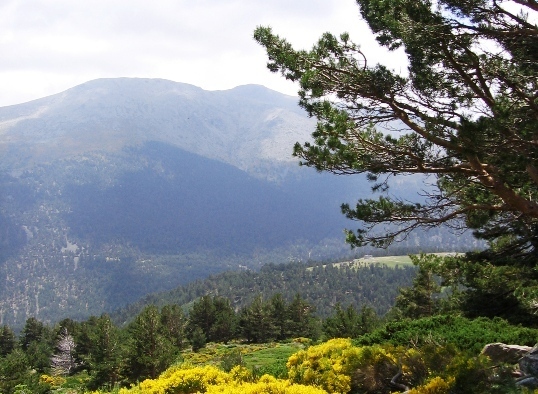
Why do I call myself Mount Oregano?
"The mountain isn't all oregano," they say here in Spain: No todo el monte es orégano.
That means that nothing is entirely easy. A patch of oregano is soft and aromatic, but a hike in the hills will have prickly and stinky moments. Not everything can be oregano.
It's an old saying. You can find it mentioned in Don Quixote de La Mancha in Chapter 36.
And while I try to behave well, I can have my rough moments.
I took the photo in Peñalara National Park in the mountains near Madrid. It was a beautiful hike, but the trail on the mountainside was not for people with poor balance — a potential for some very prickly moments.
— Sue Burke
June 9, 2012
Writing meme
The rules:
1. Go to page 77 (or 7th) of your current ms.
2. Go to line 7.
3. Copy down the next 7 lines – sentences or paragraphs – and post them as they’re written. No cheating.
From the current chapter of an untitled novel:
"Injuries have happened there," I said.
She raised her hand with part of a finger missing. "Wear gloves and don't take them off. And don't be stupid like Queen Rust. The corals hunt, and they have a pretty good range. I wrote a full report about our visit. You can read it."
A long report, probably, and in Classical English. I didn't reply.
After a moment, Karola said, "I'll read it and send you a summary."
"Oh," Honey added, sitting straight up with enthusiasm, "and you want Arthur to be on your team. He's great there, and he'll keep you safe."
— Sue Burke
June 8, 2012
Soccer madness

While I was doing the weekly grocery shopping here in Madrid, I could have gotten a soccer ball with a purchase of gazpacho, but I already had gazpacho in the refrigerator, so I let that deal go by. But I did buy some olives, and they came with a stick of facepaint in the color of Spain's flag, red and yellow and red.
Why all this? Because play has begun in the 2012 European Football (Soccer) Championship. Spain is the returning champion team (and the World Cup reigning champion). A trip to the grocery store reveals the excitement.
Me? I'll be cheering for Spain. Loudly. But not as nearly loud as a lot of my neighbors. And I need to find some kids upon whom to inflict some facepaint.
http://www.uefa.com/uefaeuro/index.html
http://en.wikipedia.org/wiki/UEFA_Euro_2012
-- Sue Burke



